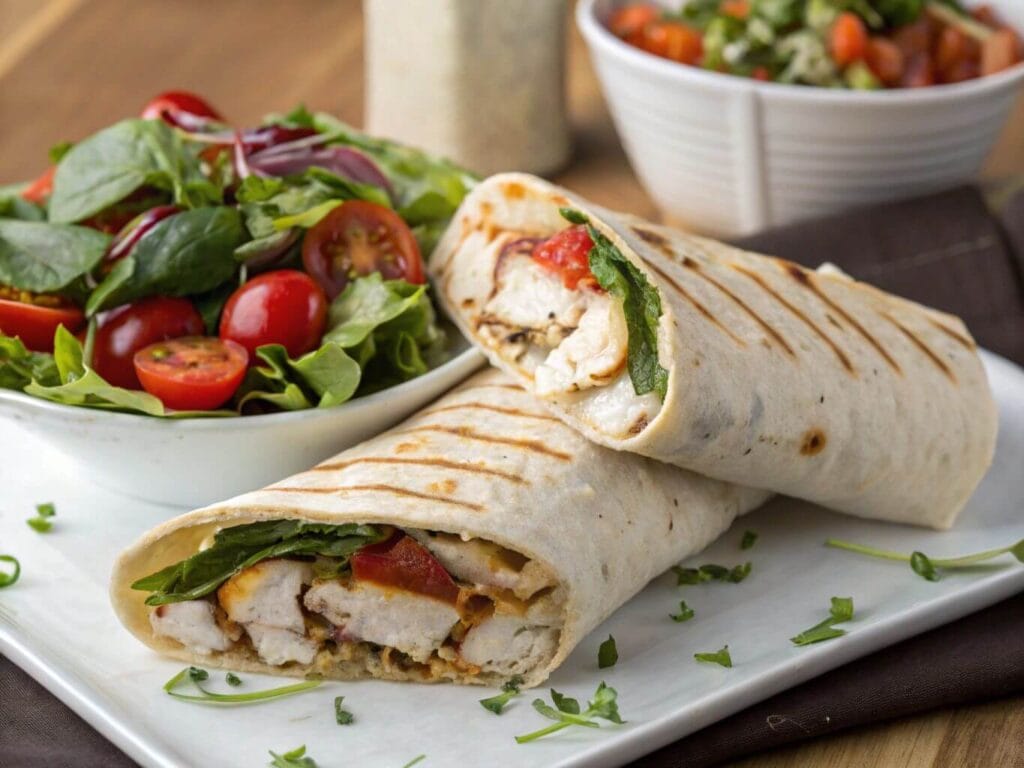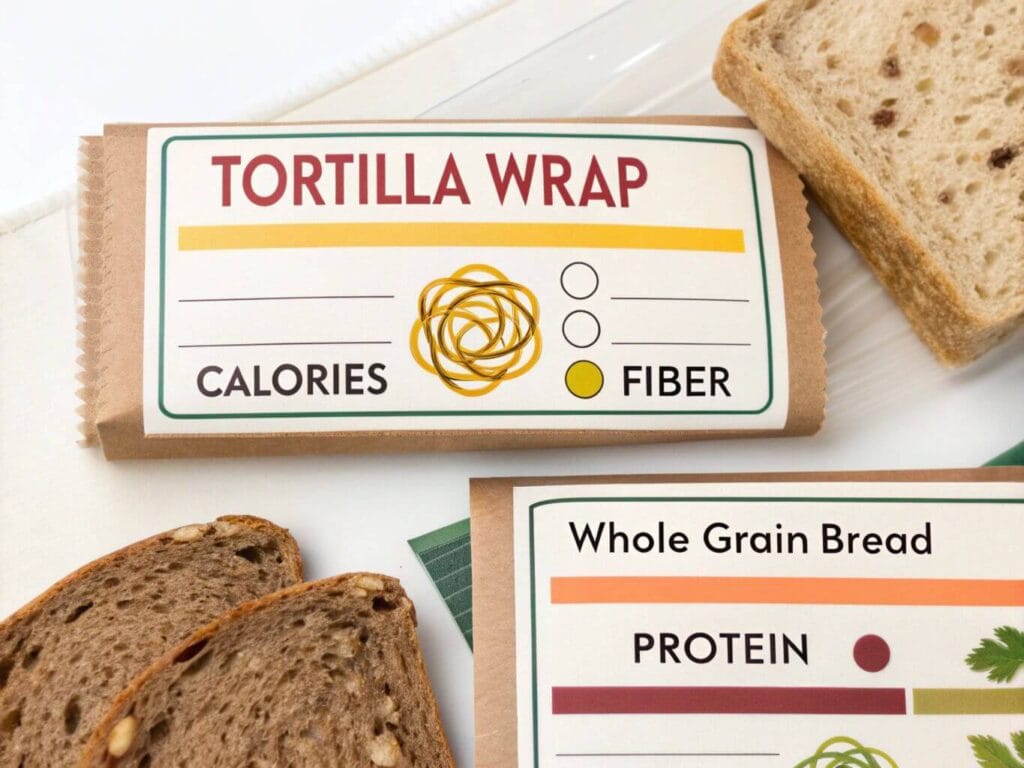Deciding between a chicken wrap and a chicken sandwich can feel like a small choice, but it often raises significant questions about health and nutrition. Wraps are sleek and portable, while sandwiches boast a satisfying heartiness. Both can be packed with protein and nutrients—or hidden calories and carbs. But which is truly healthier? In this article, we’ll break it all down, from nutritional comparisons to tips for customizing your meal. Whether you’re a Team wrap or a Team sandwich, you’ll have the insights to choose your goals.
Understanding the Basics: Wraps vs. Sandwiches

What Defines a Wrap?
Wraps are a modern culinary favorite, combining versatility with a sleek, portable design. Typically, a wrap involves a soft tortilla or flatbread that encloses various fillings, from grilled chicken and fresh veggies to bold sauces and cheese. Unlike sandwiches, wraps eliminate the need for bulky bread slices, which is often seen as a healthier swap.
Nutritionally, a standard tortilla wrap is often slightly larger than a slice of bread and may contain more calories, especially when made with refined flour. However, wraps made from whole grains or low-carb options can boost fiber content while cutting down on carbs, making them popular for those on keto or low-carb diets.
Wraps also excel at holding ingredients together neatly, reducing the mess factor. They’re a go-to option for busy lunches and grab-and-go meals.
What Defines a Sandwich?
Sandwiches, the classic mealtime staple, are as versatile as wraps but have their own appeal. Built on two slices of bread, sandwiches typically layer ingredients like chicken, cheese, lettuce, and sauces. The type of bread—white, whole-grain, sourdough, or gluten-free—can significantly impact a sandwich’s nutritional value.
Whole-grain bread, for instance, is a fiber-rich powerhouse that supports digestion and helps maintain energy levels throughout the day. On the other hand, white bread often contains added sugars and fewer nutrients, making it a less optimal choice.
While sandwiches have a long history of being hearty and satisfying, they can sometimes feel heavy, especially when loaded with condiments and fried chicken. Still, their compact, two-layer format makes them easy to customize and enjoy at any time of day.
Nutritional Comparison Between Wraps and Sandwiches

Caloric Content: Wraps vs. Sandwich Bread
When asked, “Is a chicken wrap healthier than a chicken sandwich?” calories are often the first to compare. At first glance, wraps may seem lighter due to their slim design but looks can be deceiving. A standard tortilla wrap usually contains more calories than two slices of bread, especially if it’s a large, refined flour tortilla.
On the other hand, bread calories can vary widely. Two slices of whole-grain bread typically have around 150–200 calories, while some artisan or enriched bread can climb higher. In contrast, a single tortilla can range from 200–300 calories depending on its size and ingredients. It’s a tight race, but the key lies in portion control and the type of base you choose.
Macro and Micronutrient Profiles
The macronutrient breakdown is another critical factor in determining if a chicken wrap is healthier than a chicken sandwich. Wraps made from whole-grain tortillas can offer similar benefits to whole-grain bread, providing a good source of fiber, protein, and essential vitamins. However, many wraps—mainly white flour varieties—lack the nutrients and fiber found in high-quality bread.
Sandwiches also have a slight edge in terms of micronutrients if you opt for sprouted or fortified bread options. Whole-grain bread, for instance, delivers magnesium, iron, and B vitamins that support overall health. In contrast, some wraps can be heavily processed, stripping away nutrients during manufacturing.
Hidden Calories: Fillings and Condiments
What you put inside your wrap or sandwich can make or break its healthfulness. Both wraps and sandwiches are prone to hidden calorie traps like creamy dressings, cheeses, and fried chicken. For example, a seemingly light chicken Caesar wrap can pack upwards of 700 calories due to high-fat ingredients. Similarly, a fried chicken sandwich loaded with mayo can rival the wrap in calorie content.
If your goal is a healthier choice, focus on grilled chicken, fresh veggies, and light dressings. By being mindful of what’s inside, you can enjoy either option without sabotaging your meal plan.
Health Benefits of Chicken Wraps and Sandwiches
When Wraps Are the Healthier Choice
Wraps can be the healthier choice in specific scenarios. For instance, when made with whole-grain or low-carb tortillas, they can cater to low-carb diets or those prioritizing portion control. The compact wrap design often encourages less breading and pairs well with nutrient-rich fillings like grilled chicken, lettuce, and avocados.
Wraps also excel in convenience. Their sealed, portable design reduces the risk of mess, making them ideal for on-the-go meals. For people aiming to avoid excess carbs, replacing sandwich bread with a low-carb wrap can help maintain blood sugar levels and provide longer-lasting energy.
When Sandwiches Win the Health Game
Despite wraps’ appeal, sandwiches can sometimes claim the health advantage. The key lies in the bread. Whole-grain bread offers a higher fiber content than most wraps, which supports digestive health and helps you feel full longer. Sandwiches also have a long-standing advantage in simplicity, often containing fewer ingredients than their wrap counterparts.
Popular Fast-Food Chicken Wraps and Sandwiches

Top Choices for Chicken Wraps
Fast food restaurants often offer chicken wraps as a healthier alternative to their fried offerings. Grilled chicken wraps are particularly popular, boasting fewer calories and fats than their fried counterparts. For instance, Chick-fil-A and McDonald’s offer wraps filled with fresh veggies, grilled chicken, and light dressings. These are often marketed as low-calorie options for health-conscious diners.
However, not all wraps are created equal. Some fast-food chicken wraps, such as the creamy Caesar or crispy chicken varieties, can rival sandwiches regarding calories and saturated fat. The choice of tortilla also plays a role; refined flour wraps may add extra calories without the benefits of fiber-rich whole grains.
If you want inspiration to recreate these wraps at home, try Freshness Recipes’ Grilled Chicken Wrap Recipe for a healthier, homemade alternative.
Famous Chicken Sandwich Options
Meanwhile, chicken sandwiches dominate the fast-food landscape with various styles. From grilled options to crispy, fried classics, sandwiches cater to a broad audience. Grilled chicken sandwiches are typically lower in calories and offer a cleaner taste, allowing the ingredients to shine. Conversely, fried chicken sandwiches, while flavorful, often come with a higher fat and calorie count.
For a balanced meal, choose grilled over fried and pair your sandwich with a side salad or fruit instead of fries. Some chains, like Subway, allow you to fully customize your sandwich with healthier bread options and plenty of vegetables.
Choosing the Healthier Option
Decoding the Ingredients List
Examining the ingredients list is crucial when deciding whether a chicken wrap is healthier than a chicken sandwich. Look for wraps or sandwiches made with whole grains and free of added sugars. Ingredients like grilled chicken, fresh vegetables, and light sauces contribute to a nutritious and satisfying meal.
Avoid items loaded with creamy dressings, excessive cheese, or fried toppings. These additions can significantly increase the calorie count, tipping the scales against your health goals.
Customizing for Better Nutrition
Customization is your best tool for making healthier choices. Opt for grilled chicken over fried, and use condiments sparingly. Add nutrient-dense toppings like spinach, avocado, and tomatoes to boost flavor and nutritional value.
Want to try something new? Check out Freshness Recipes’ guide on making chicken wraps that are not soggy for tips on keeping your wraps fresh and delicious.
Environmental and Practical Considerations for Wraps and Sandwiches
Sustainability of Ingredients
When comparing wraps and sandwiches, it’s worth considering their environmental impact. Tortillas and bread are staples, but their production processes can vary regarding sustainability. For example, wraps made from whole grains or organic ingredients tend to have a smaller environmental footprint than those made with refined flour. Similarly, bread made with locally sourced grains can be more eco-friendly than mass-produced options.
Both wraps and sandwiches can be environmentally friendly if you prioritize sustainable ingredients. Opting for free-range or organic chicken, locally grown vegetables, and eco-conscious packaging can reduce your meal’s overall impact.
Practicality and Portability
Another factor in answering whether a chicken wrap is healthier than a chicken sandwich lies in practicality. Wraps are undeniably more portable, and their sealed design makes them less messy to eat on the go. They’re a favorite for packed lunches or quick snacks.
Sandwiches, however, are easier to assemble and more forgiving regarding portion control. You can quickly adjust the size by cutting a sandwich in halves or quarters, making it ideal for sharing or saving for later. Due to their simplicity, sandwiches offer a slight edge for those who meal prep.
Final Thoughts and Recommendations
Answering the Key Question
So, is a chicken wrap healthier than a chicken sandwich? The answer depends on various factors, including your dietary goals, the ingredients used, and how the meal is prepared. Wraps can be healthier when made with whole-grain tortillas and filled with grilled chicken and fresh vegetables. However, sandwiches made with whole-grain bread can provide similar nutritional benefits while offering the added advantage of fiber.
If you’re watching calories, paying attention to portion sizes and avoiding calorie-dense condiments is essential. Choosing between a wrap and a sandwich depends on your preferences and lifestyle.
Finding the Right Balance
The best choice is the one that meets your health goals and satisfies your taste buds. Experiment with different recipes, try new ingredients and don’t hesitate to customize your meal to suit your needs. Whether you lean toward a wrap’s portability or a sandwich’s heartiness, both can be nutritious when prepared thoughtfully.
For more healthy meal ideas, consider exploring Freshness Recipes’ collection of chicken wrap recipes and discover how to keep your wraps fresh and delicious.
Common Mistakes to Avoid When Choosing Wraps or Sandwiches
Overloading with High-Calorie Fillings
One of the most common pitfalls when deciding if a chicken wrap is healthier than a chicken sandwich is overloading either option with calorie-dense ingredients. Items like fried chicken, creamy dressings, and cheese can quickly turn a seemingly healthy wrap or sandwich into a calorie bomb. While these add-ons may enhance flavor, they often compromise the healthiness of your meal.
Add grilled chicken, fresh vegetables, and light sauces to avoid this. Low-fat dressings or spreads like hummus can boost flavor without adding unnecessary calories. It’s all about balance—keeping your fillings nutritious while still delicious.
Ignoring Portion Sizes
Another frequent mistake is overlooking portion sizes. Wraps, especially those made with large tortillas, can consume more calories than expected. Similarly, oversized sandwich bread or generous portions of fillings can add extra carbs and fats.
Stick to standard-sized portions and be mindful of the tortilla or bread size. If you’re still hungry, pair your meal with fresh fruit or a small salad instead of upsizing the wrap or sandwich.
FAQs and Expert Insights
Are Wraps Always Healthier Than Sandwiches?
No, wraps are not automatically healthier than sandwiches. While wraps may seem lighter, their tortillas can contain more calories and refined carbs than two slices of whole-grain bread. The key lies in the choice of fillings, cooking methods, and portion control.
What’s Better for Weight Loss: Wraps or Sandwiches?
Both wraps and sandwiches can work for weight loss if they’re made with whole ingredients. Opt for grilled chicken, leafy greens, and whole-grain bases to maximize nutritional value while keeping calories in check. If portion control is your priority, sandwiches might be easier to customize.
Can Wraps and Sandwiches Be Keto-Friendly?
Yes, both wraps and sandwiches can be adapted for a keto diet. Low-carb tortillas and keto-friendly bread substitutes are widely available, making it easy to enjoy either option while staying within carb limits.

